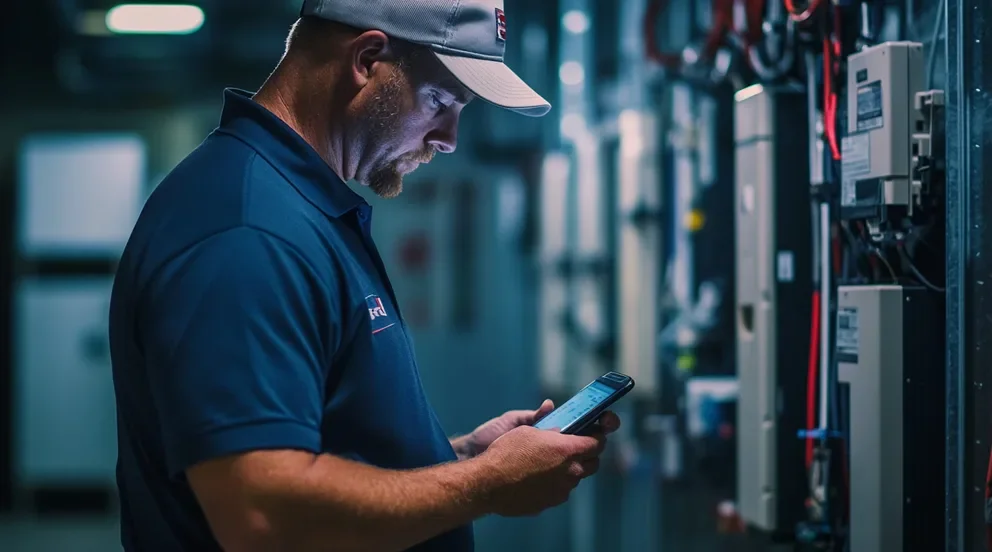Staying on top of electrical maintenance takes more than tools and talent—it takes the right app in your crew’s hands. When breakdowns hit, or scheduled service stacks up, you can’t afford to sort through paperwork or chase down updates. That’s where having an electrical maintenance app tailored to electricians actually doing the work makes the difference.
For contractors in the electrical industry, maintenance apps help your team keep track of service calls, inspections, repairs, and equipment checks—right from the field. But not all apps are made with electricians in mind. The best ones know the chaos of the job and give you what you need without slowing you down. This guide breaks it all down so you can skip the guesswork. Here’s what we’re covering:
- Choosing the right electrical maintenance app for your needs
- 6 key features to look for in quality electrical maintenance apps
- 3 types of electrician maintenance apps
- 10 best electrician maintenance apps for all types of teams & projects
- 7 benefits of using electrician maintenance apps
- 4 important electrician maintenance app FAQs answered
Let’s start by breaking down how to figure out which type of electrical maintenance app actually matches how your team works in the field. A good fit is about keeping pace with the way your techs get the job done.
Choosing the right electrical maintenance app for your needs
Electricians don’t just pick tools—they depend on them, and the same goes for apps. Whether you're handling scheduled service, urgent repairs, or system inspections, the electrical maintenance app you choose has to match how your team moves in the field. It's not about features on paper—it’s about whether the app can keep up when the pressure hits. Here’s what to think through before locking anything in:
- Workflow fit – Does the app support how your techs actually work? Can they log issues while on-site without flipping between tabs? Does it reduce steps or just move the paperwork to a screen?
- Team size & setup – Does the platform scale with the number of techs and projects you’re juggling? Can it handle both solo jobs and full team assignments? Will it help coordinate between field and office, or just create another layer?
- Job type compatibility – Does the app work across the type of maintenance work you handle—emergency repairs, scheduled service, recurring inspections? Can it adapt to both commercial and residential job demands?
- Support & updates – How fast is the support team when something breaks? Are they used to working with electrical contractors or just general users? Do they push updates that fix real problems electricians face?
- Features – Does it offer the features that actually help electricians in the field—like asset history, real-time service logging, mobile punch-in/punch-out, and service reminder alerts? Can it track parts used on each job and flag future maintenance?
Before diving into the specific features you should expect in any solid electrical maintenance app, it’s worth breaking down which ones actually make life easier for field electricians—and which ones just add clutter. Let’s look at what matters most.
6 key features to look for in quality electrical maintenance apps
Not every app claiming to help electricians in the field actually holds up under pressure. What separates a true electrical maintenance app from just another job board or task tracker is how well it supports the way maintenance techs work—in real time, with real constraints.
Whether you're responding to service calls or logging preventive maintenance, the features below are what keep your operation sharp and your crew efficient.
1. Real-time scheduling and dispatching
When jobs stack up, you can’t afford to shuffle calls manually or lose track of who’s handling what. A dependable electrical maintenance app includes both field service scheduling and dispatch software built to keep things moving in real time. You need to assign, reassign, and update jobs without waiting for a callback or a laptop.
Let’s say a tech finishes a panel inspection early. Instead of calling the office, they get instantly rerouted to the next service call nearby—no downtime, no confusion. That’s the difference between a system that reacts and one that’s always a step ahead.
2. Service agreement tracking
Staying on top of long-term maintenance contracts is critical, especially for commercial properties with recurring work. Your app should make it easy to set, schedule, and auto-renew those jobs. That’s where strong service agreement management plays a key role—turning recurring work into repeat revenue.
Say you’ve got 12 rooftop units under quarterly maintenance across three buildings. Instead of creating individual reminders, your app tracks every service milestone and notifies the crew when it's time. No missed inspections. No awkward client calls about overdue work.
3. Invoicing built into the workflow
If your invoicing lives on a separate system from your service reporting, it’s slowing you down. With built-in invoicing tools, your techs can finish a job, log the work, and generate the invoice on the same platform—without doubling back later.
For example, after completing a breaker replacement, your tech enters the parts used and labor time, then hits send on the invoice before leaving the site. That means no lost paperwork and no guessing what happened later that day.
4. Mobile quote and estimate tools
A solid electrical maintenance app should also double as your quoting tool in the field. With quoting software, you can generate estimates based on real job conditions—no spreadsheets, no guesswork.
Say your tech finds a failing disconnect during a routine service. Instead of writing notes to estimate later, they pull up the app, add the parts and labor, and get client approval on the spot. That turns one job into two without the back-and-forth.
5. Time tracking tied to actual jobs
Without accurate time tracking software, you’re either overestimating labor or missing billable hours. The best apps let electricians clock in by job, not just by day, giving you a clearer picture of where time goes—and where it leaks.
For example, if a crew spends extra time troubleshooting a transformer issue, the hours tie directly to that job. You get the billing detail, the crew gets paid right, and nothing gets lost in translation.
6. Payment processing in the field
Getting paid should be just as easy as doing the work. Field-ready payment tools let your techs collect payment on-site, whether it’s a card swipe or a digital invoice link.
Imagine a client who wants to pay immediately after a lighting system repair. Your tech sends the invoice and processes the payment before leaving the lot. No follow-up calls. No waiting for checks in the mail.
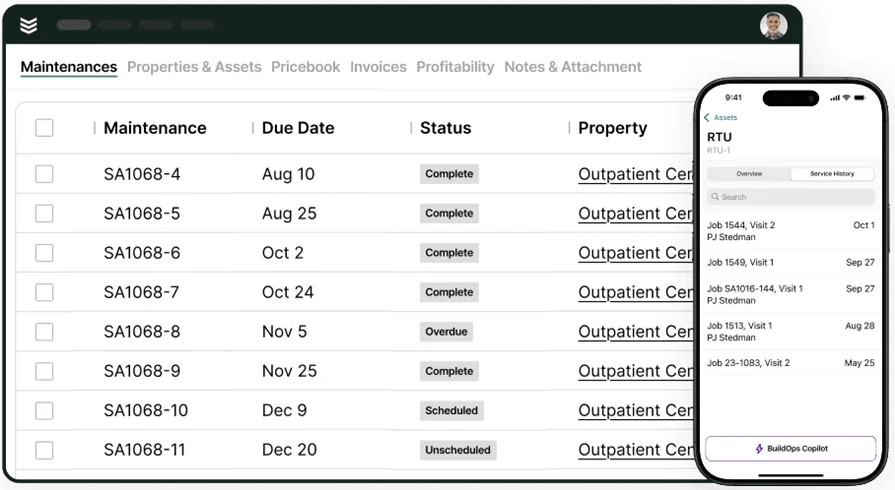
Service Agreement & Maintenance app
Built right into the BuildOps app to completely automate your service calls.
Other valuable features to have in an electrical maintenance app
Beyond the essentials, some electrical maintenance apps come with extra tools that give contractors even more control and visibility across their field operations. These features aren’t always top priority when choosing an app, but they can save time and help teams run tighter, more organized jobs—especially when scaled across multiple techs and job sites.
- CRM and customer tracking – A built-in CRM access for electricians helps manage client data, service history, and communication without switching systems. This keeps everything from first contact to follow-ups in one place—especially useful for teams juggling recurring clients and jobsite notes.
- Fleet visibility tools – With fleet tracking software, managers can see where every truck is in real time, check fuel usage, and keep tabs on vehicle maintenance. While not essential to every shop, this can be a big help for multi-vehicle teams running tight service routes.
- Job and performance reporting – Reporting features allow you to track technician productivity, job turnaround times, and service trends. For teams focused on improving performance or scaling operations, this data turns daily work into long-term insights.
While these extra features can sharpen your workflow, they don’t all carry the same weight. Some electrical maintenance apps are built for quoting, others for diagnostics, and a few for full-scale service management. Knowing which type you’re dealing with makes it easier to choose the one that actually fits how your team works in the field. Let’s break down the main categories.
3 types of electrician maintenance apps
Electrical maintenance apps come in a few different forms depending on what part of the job they’re built to support. Some are made to manage entire service workflows, others serve as technical tools in the field, and some are focused on very specific use cases.
Here’s a breakdown of the three most common types electricians run into—and how each one fits into the day-to-day.
- Field service management: These apps are built to manage everything that happens between the office and the jobsite—scheduling, dispatch, job tracking, customer history, and invoicing. They give you the full picture of what’s happening across your team and let your techs handle jobs without needing a stack of paperwork. This type is ideal for teams focused on maintenance and repair service calls, where timing, coordination, and task tracking matter most.
- Electrical calculations: Designed to handle technical checks in the field, these apps help with load calculations, breaker sizing, conduit fills, and other code-based tasks. Electricians often use them during quoting or installs when you need quick answers that hold up to inspection. They don’t manage jobs or dispatch, but they save time when working through specs or system upgrades.
- Specialized apps: These focus on a single task or workflow—like thermal imaging, circuit mapping, or breaker panel labeling. They’re used alongside other tools but serve a specific purpose that helps with diagnostics, troubleshooting, or documentation. Contractors use these apps when a job calls for something niche or technical that standard maintenance platforms don’t cover.
Each of these app types plays a different role. Before diving into the top electrician maintenance apps, it helps to know which category best fits your crew’s daily work and what you actually need the software to handle.
10 best electrician maintenance apps for all types of teams & projects
Whether you run solo or manage multiple crews, choosing an electrical maintenance app isn’t about what looks good on a feature list—it’s about what holds up when your day gets packed with service calls, emergencies, and change orders.
The best apps work the way electricians do: quick, clear, and built for the field. Each solution below fits a different kind of contractor, so you can find the one that lines up with how your team actually works.
1. Best for commercial: BuildOps
BuildOps is designed for commercial electrical contractors managing everything from preventive maintenance to multi-tech service calls. It connects dispatch, work orders, quoting, and invoicing in one field-ready system, letting your office and techs move together without the usual gaps. The app stands out for its mobile-first design, especially useful for electricians who need to log work, parts, and notes on-site without flipping between tools.
App type: Cloud-based
How pricing works: Per user, typically on an annual contract
Features for service maintenance: Includes technician job tracking, service history logs, time entry, quote-to-invoice tools, and live updates across teams
What sets it apart for commercial: Built specifically for large-scale service operations, it supports complex job coordination, multi-building maintenance, and recurring contract work without slowing down field reporting. It handles scheduling, real-time updates, asset tracking, and service agreements all under one roof—making it a strong fit for teams that can’t afford to miss a beat on-site.
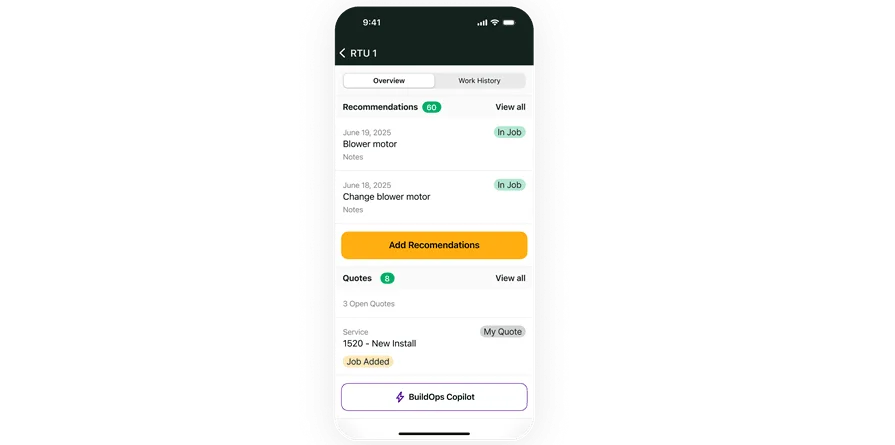
Take a closer look at BuildOps
Manage your entire field service operation from a single, easy-to-use platform.
2. Best for residential: FieldEdge
Image Source: FieldEdge
FieldEdge helps smaller residential teams manage recurring service visits, invoicing, and dispatch from a centralized platform. It supports mobile access, which means electricians can view job histories, log parts, and send invoices without calling the office. Its strength is in residential workflows, like regular panel checks, fan replacements, and lighting repairs. It may not be the best fit for commercial contractors needing more advanced asset management or larger project oversight.
App type: Cloud-based
How pricing works: Subscription model per user; pricing depends on team size and feature tier
Features for service maintenance: On-the-go access to customer history, flat rate pricing, quick invoicing, and real-time schedule visibility
What sets it apart for specialization: Tailored to fast-moving residential service teams, it prioritizes ease of use and speed—making it ideal for shops doing volume work in tight geographic areas.
3. Best for general contractors: Zoho FSM
Image Source: Zoho
Zoho FSM supports general service workflows and is part of the larger Zoho software suite. It works well for teams already using Zoho’s CRM or finance tools, offering job scheduling, work order tracking, and simple reporting. The integration between customer management and field ops makes it an efficient choice for electricians who handle occasional maintenance work within broader contracting jobs. However, it may not be the best option for contractors who need a tool built specifically for electrical systems, service tracking, or compliance workflows.
App type: Cloud-based
How pricing works: Tiered monthly pricing per user
Features for service maintenance: Includes job scheduling, appointment reminders, client portals, and limited asset tracking
What sets it apart for specialization: Zoho FSM offers a lightweight, all-in-one option for general contractors who want to bundle maintenance with other services without needing multiple platforms.
4. Best for small to mid-sized businesses: ServiceM8
Image Source: ServiceM8
ServiceM8 is a simple, user-friendly app built for small electrical shops managing service calls, quotes, and invoices on the fly. Its clean interface helps techs access job info, upload photos, and take payments—all from a phone or tablet. Great for electricians who need to handle everything themselves without getting bogged down in setup or admin. That said, it may fall short for teams that need deeper reporting or more control over job costing and multi-crew coordination.
App type: Cloud-based
How pricing works: Tiered monthly plans; pay-as-you-go options available
Features for service maintenance: On-site job updates, quote generation, invoice delivery, and basic scheduling
What sets it apart for specialization: ServiceM8 keeps the process tight and mobile-focused, ideal for smaller teams that need to move quickly between jobs without office oversight.
5. Best for electrical installations: Trace Software
Image Source: Trace
Trace Software offers tools for designing and calculating complex electrical systems, making it a strong pick for contractors who focus on installs rather than ongoing maintenance. It’s best known for its engineering-grade features like circuit diagram creation and load balancing tools. However, it’s not well suited for service-driven teams needing real-time dispatch or invoicing built into a mobile workflow.
App type: Desktop-based
How pricing works: License-based, usually a one-time purchase or annual subscription
Features for service maintenance: Technical calculations, electrical system modeling, wiring schematics
What sets it apart for specialization: Perfect for contractors working on new builds or large-scale upgrades where technical planning is just as critical as execution.
6. Best for electrical design: ElectricalOM
Image Source: ElectricalOM
ElectricalOM is built for engineers and contractors who need to design and validate electrical systems before installation. It supports compliance with various codes and helps identify faults or overloads in planning stages. That makes it especially useful for those focused on precision and regulation-heavy projects. Still, it’s not intended for managing ongoing service work or technician scheduling in the field.
App type: Desktop software
How pricing works: One-time license fee, plus optional support or upgrade costs
Features for service maintenance: System design validation, fault level calculations, cable sizing, and circuit simulation
What sets it apart for specialization: Tailored to electrical designers and contractors dealing with planning, it offers depth where apps focused on scheduling and service tracking don’t.
7. Best for electrical diagnostics: Schneider Electric
Image Source: Schneider Electric
Schneider Electric offers a suite of mobile and hardware-connected apps that help electricians monitor systems, run diagnostics, and track energy data. These tools are strong when you’re working with Schneider-branded equipment and need fast fault detection or system status checks. The downside? They’re typically tied to Schneider ecosystems and don’t handle broader field service needs like quoting, scheduling, or invoicing.
App type: Mobile app, sometimes paired with hardware
How pricing works: Varies by tool—some are free, others are part of hardware bundles or licensing
Features for service maintenance: Equipment monitoring, real-time diagnostics, system alerts
What sets it apart for specialization: Strong for techs doing service or diagnostics on Schneider-supported systems, especially in industrial or facility settings.
8. Best for electrical troubleshooting: HGL Tech Solutions
Image Source: HGL Tech
HGL Tech Solutions offers a mobile-first platform focused on diagnostics, issue logging, and fast communication between field techs and supervisors. It helps electricians identify faults, document service results, and share details in real time—especially useful when dealing with repeat issues or unknown system failures. However, it may not be ideal for contractors who need built-in scheduling, quoting, or larger team coordination.
App type: Cloud-based
How pricing works: Subscription-based; pricing varies based on number of users and modules
Features for service maintenance: Troubleshooting logs, image uploads, technician notes, asset tagging
What sets it apart for specialization: HGL Tech Solutions excels in fast-paced environments where techs need to record and resolve service problems on the spot. It’s strong in diagnostics but light on broader field service workflows.
9. Best for growing electrician business: Jobber
Image Source: Jobber
Jobber is built for small and growing service businesses that need help keeping their work organized without adding extra admin. Electricians can manage jobs, create quotes, and get paid through one interface, which helps scale operations without overcomplicating the process. Still, Jobber may not be the best choice for larger teams needing advanced technician tracking, asset history, or multi-location coordination.
App type: Cloud-based
How pricing works: Tiered monthly pricing based on users and access level
Features for service maintenance: Online booking, mobile job tracking, quick estimates, and payments
What sets it apart for specialization: Jobber supports growth by simplifying the essentials—quoting, scheduling, and invoicing—into one easy-to-use platform. Ideal for smaller teams that want to get more done without a steep learning curve.
10. Best for load calculation: ElectriCalc Pro
Image Source: Electricalc
ElectriCalc Pro is a specialized app for doing fast, code-compliant electrical calculations. It’s ideal for licensed electricians who need to check voltage drop, conduit fill, wire sizing, and breaker loads in the field. The app is loaded with NEC tables and formulas, saving time and reducing errors during inspections or estimates. It’s not designed for dispatching, invoicing, or managing job schedules—so it works best alongside a broader maintenance platform.
App type: Mobile app / Calculator software
How pricing works: One-time purchase through app stores or bundled with physical calculator
Features for service maintenance: Built-in NEC data, automatic load calculations, voltage drop analysis
What sets it apart for specialization: ElectriCalc Pro focuses entirely on electrical calculations. For contractors doing field estimates or checking spec compliance, it delivers quick answers without pulling out the codebook.
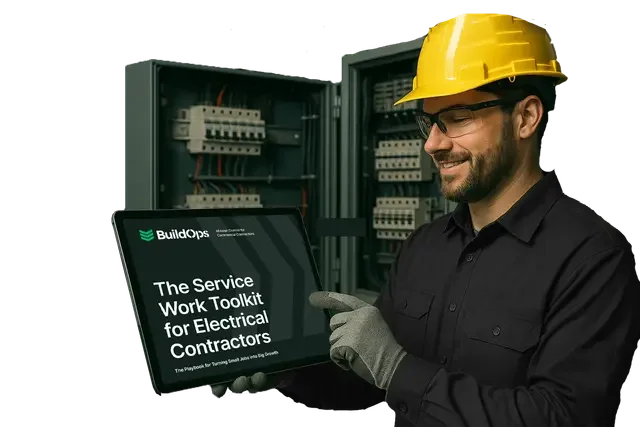
Electrical Service Work Toolkit
Learn how top electricians manage their service work better.
7 benefits of using electrician maintenance apps
Electrical maintenance apps don’t just organize schedules or log service calls—they give contractors the tools to tighten up operations, cut back on admin stress, and keep techs focused on the work that matters.
From speeding up invoicing to keeping jobs from slipping through the cracks, the benefits stack up fast when the app actually fits the way electricians move in the field. Here’s where the impact really shows.
1. Faster scheduling, fewer job delays
With an electrical maintenance app, assigning work becomes a quick tap—not a call or a paper slip. When techs can see updates in real time, it reduces confusion and shortens the lag between scheduled service and actual work. This leads to fewer missed appointments, tighter routing, and better crew utilization. You can see how smart tools like this play out in the field in this breakdown of electrical contractor scheduling apps.
2. Less time spent chasing payments
When invoicing is built into the same app techs use to close jobs, billing happens on the spot. That means electricians can wrap up service, generate an invoice, and collect payment before leaving the site—no office bottleneck or client delay. For a deeper look into how this reduces payment friction, here’s a solid electrician invoicing guide built around field-ready workflows.
3. Reduced quoting errors and back-and-forth
A quoting tool inside an electrical maintenance app helps techs build and send estimates using real labor rates and materials—no more handwritten notes or spreadsheet mistakes. This leads to better client trust and faster job approvals. If you handle service work and quoting in the field, this electrical quote app guide covers how it all ties together without dragging you back to the office.
4. Stronger visibility into customer history
With client data stored inside the same system your team uses for service, everyone can pull up job notes, past repairs, and upcoming maintenance. This saves time on-site and helps your crew show up prepared. Better yet, it cuts down on repeat questions from customers. For electricians juggling regular service clients, tools like those in the best CRM for electrical contractors help keep it all organized without extra steps.
5. More accurate bids
By combining past job data, technician input, and real material costs, maintenance apps give you more confidence in your numbers. That means fewer underpriced jobs and better win rates. It also helps standardize bids across your team, so everyone’s quoting the same way. For electrical teams who bid often, check out how an electrical bidding app can connect the dots between estimating and fieldwork.
6. Less stress for techs in the field
Having everything in one place—job details, service history, parts lists—helps techs do their jobs without guesswork. It cuts down on calls to the office and keeps things moving when a wrench gets thrown into the schedule. A solid electrical maintenance app becomes the go-to tool they can rely on every day.
7. Better service tracking and accountability
When updates, photos, and time logs are tracked in real time, it’s easier to hold the line on quality. Managers can spot issues early, verify work, and review service history without playing phone tag. That accountability helps catch small issues before they become big ones—and gives your clients the confidence that nothing gets missed.
4 important electrician maintenance app FAQs answered
Electricians rely on tools that work just as hard as they do—apps included. When you’re managing field service from both the jobsite and the office, the electrical maintenance app you run with has to keep up with real-world demands. These FAQs break down what these apps actually do, how they function in the field, and how to get the most out of them from day one.
1. What is an electrician maintenance app?
An electrician maintenance app is a tool that helps electrical contractors manage field service tasks like scheduling, dispatch, service logging, quoting, invoicing, and customer tracking—all from a mobile device or web platform. Think of it as the control center for your entire service operation.
Electricians use these apps to reduce downtime, eliminate paperwork, and improve communication between field techs and the office. What makes these apps different is their focus on real-time job updates and features tailored specifically for electrical service work—whether it’s routine inspections or emergency repairs.
2. How do electrical maintenance apps work?
Electrical maintenance apps connect field and office operations through a central dashboard, accessible from smartphones, tablets, and computers. Here’s how they typically function:
- Scheduling: Office staff assign jobs to available techs based on location, availability, or skill.
- Dispatching: Techs receive real-time job details including location, service history, and equipment notes.
- On-site tracking: Electricians log work, add notes/photos, and record time or parts used directly from the field.
- Quoting & invoicing: Some apps let you create estimates and invoices on the spot—no follow-ups needed.
- Reporting & records: All data is stored for future reference, compliance, or performance tracking.
This workflow keeps things moving fast, reduces admin time, and makes sure nothing falls through the cracks.
3. Are electrician maintenance apps worth the cost?
Yes—for most field service teams, the time saved and mistakes avoided usually pay for the tool itself. Here’s why:
- Cuts down paperwork and back-and-forth
- Keeps field techs productive with all info in one place
- Reduces missed appointments, double-bookings, or billing delays
- Improves quote accuracy and service follow-through
- Helps you win more business by keeping clients informed and confident
For electrical contractors, especially those juggling recurring service or high-volume jobs, the return on investment becomes obvious within weeks—not months.
4. Best practices for implementing an electrical maintenance app
Rolling out a new app can either be smooth or chaotic—depending on how you handle setup, training, and day-to-day adoption. Here are ten straightforward tips to help you get it right from the start:
- Start with a pilot crew – Test with a small group of techs first to spot issues early
- Get buy-in from the field – Make sure techs know how it helps them, not just the office
- Train in real-world conditions – Let crews try the app during live jobs, not just demos
- Build standard workflows – Define how your team should log jobs, notes, and invoices
- Customize job templates – Pre-load common service types to save time and avoid errors
- Use alerts and reminders – Set up automated notifications for jobs, quotes, and follow-ups
- Connect it to your invoicing – Make sure the app ties into how you bill customers
- Update regularly – Keep it fresh with new parts, rates, and service tasks as you grow
- Track what’s working – Use built-in reports to review crew performance and job flow
- Support your team – Be available for questions and reward techs who use it right
These best practices help electricians avoid rollout headaches and turn the app into a tool the whole team trusts in the field.
Most electrical maintenance apps handle part of the job—maybe it’s quoting, or maybe dispatch. But very few platforms bring it all together for electrical contractors who need to run their operations without switching tools mid-task. From field scheduling and invoicing to service tracking and reporting, BuildOps covers what others miss. The tools and features listed in this guide aren’t standard in most software—but they come built-in with BuildOps, designed specifically for commercial field service teams that can’t afford to miss a beat.
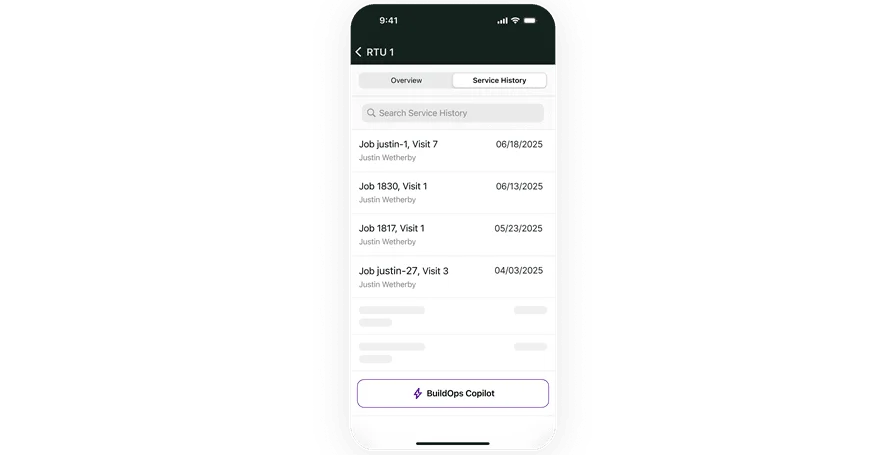
Want to see BuildOps in action?
Book more electrical jobs, keep crews aligned, and get things done.




